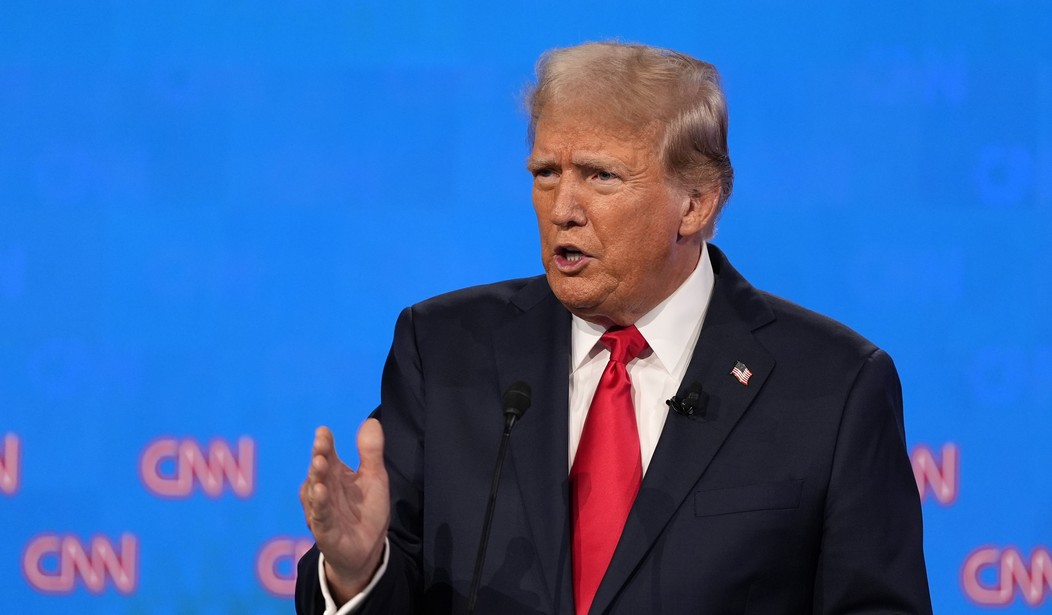It's not very often that one can accuse Russia's UN Ambassador Vasily Nebenzya of being in the same ZIP Code with the Truth but that even happened Monday. At a news conference held in conjunction with Russia assuming the presidency of the UN Security Council (consider that for a moment), Nebenzya was asked to comment on former president Donald Trump's assertion that he could end Putin's War in Ukraine in "24 hours." Trump made that claim at least three times in May to July 2023. Here, he is making it during an interview with, of all people, Nigel Farage.
“That deal would be easy. A lot of it has to do with the money. That war has to be stopped. It is a disaster.”
Two other occasions were with Fox News personalities Maria Bartiromo and Sean Hannity.
Nebenzya responded, "The Ukrainian crisis cannot be solved in one day."
Trump seems to be on course to return to the White House, where Putin's War will be a significant foreign policy problem. Because he has refused to describe how he'd go about ending the war, and now that both parties to the conflict have said that it can't be done, it is only fair to examine his claim.
Right now, Vladimir Putin has dueling two proposals. One of those, from May, offers to begin negotiations after freezing the lines where they are. Putin's counterproposal to his May proposal came a month later.
Speaking at a meeting with his top diplomats in Moscow, Mr. Putin described Russia’s demands as “very simple.” He said that Ukraine must withdraw its troops from its entire Donetsk, Kherson, Luhansk and Zaporizhzhia regions, which he officially claimed as part of Russia in September 2022, even though Russia does not control all of the territory. Ukrainian forces control the two major cities in the Kherson and Zaporizhzhia regions.
Mr. Putin also said that Ukraine must abandon its plans to join NATO and that the West must lift all sanctions imposed on Russia. Under those conditions, he said, Russia would “immediately issue an order to cease fire and start negotiations.”
Both of them lock in territory occupied by Russia since the invasion. The second proposal is essentially unconditional surrender by Ukraine and capitulation by the West in exchange for Putin agreeing to talk about something.
BACKGROUND:
The New Russian Peace Deal Shows Why Peace Between Russia and Ukraine Isn't Possible Yet
Putin Delivers Ultimatum to Ukraine and the West – RedState
Zelensky's position has been consistent since May 2022. His demands are a return to pre-invasion borders, non-interference in Ukraine's domestic and foreign policy, the return of all Ukrainians deported by Russia, and selected Russian officials to make a cameo appearance at The Hague. The status of Luhansk, Donetsk, and Crimea is only a subject for negotiation after a ceasefire. Zelensky also said that any proposal must be presented to the Ukrainian people in a referendum.
What we do know about any Trump plan seems to involve Ukraine acceding territory to Russia in exchange for Russia talking. The plans are ever-changing. In April, this trial balloon was floated.
Trump’s proposal consists of pushing Ukraine to cede Crimea and the Donbas border region to Russia, according to people who discussed it with Trump or his advisers and spoke on the condition of anonymity because those conversations were confidential. That approach, which has not been previously reported, would dramatically reverse President Biden’s policy, which has emphasized curtailing Russian aggression and providing military aid to Ukraine.
As he seeks a return to power, the presumptive Republican nominee has frequently boasted that he could negotiate a peace deal between Russia and Ukraine within 24 hours if elected, even before taking office. But he has repeatedly declined to specify publicly how he would quickly settle a war that has raged for more than two years and killed tens of thousands of soldiers and civilians.
In late June, the plan was to bully Ukraine and beg Moscow.
Kellogg—who, like Fleitz, served as a chief of staff in Trump’s National Security Council during Trump’s presidency—said the plan would simultaneously involve telling Putin that a refusal to negotiate with Ukraine would lead to the U.S. ramping up its aid to Kyiv. A ceasefire would take place based on existing battle lines while the hypothetical peace talks took place.
“We tell the Ukrainians, ‘You’ve got to come to the table, and if you don’t come to the table, support from the United States will dry up,’” Kellogg told Reuters of the plan. “And you tell Putin, ‘He’s got to come to the table and if you don’t come to the table, then we’ll give Ukrainians everything they need to kill you in the field.’”
A research paper from the America First Policy Institute, a Trump-aligned think tank where Kellogg and Fleitz have leadership roles, reportedly outlines the central proposals of the plan. The paper says the U.S. and other NATO countries should make an offer to Russia to “put off NATO membership for an extended period” in exchange for a peace deal and security guarantees in order to “convince Putin to join peace talks.”
Trump doesn't have a plan to end the war in Ukraine in 24 hours or even 24 months. The plans all proceed from the false assumption that America has the clout to bring both sides to the table. It doesn't. The reason it doesn't have the clout is that neither side sees it in their interest to stop fighting.
No one really cares what Ivan-in-the-street thinks about the war because public opinion doesn't matter in Putin's Russia. In Ukraine, the only position that gets over 50% popular support is Russia withdrawing to pre-2014 boundaries. Even if Zelensky wanted to accept the juvenile plan put forward by Kellogg and Fleitz, he would not be able to do so and remain in office. Neither could the next president be elected on a platform of negotiating away Ukrainian territory.
Ukrainian support for peace options pic.twitter.com/EuZ4wokxT4
— streiff (@streiffredstate) July 3, 2024
Trump and his people seem to be under the illusion that the US is providing the majority of aid to Ukraine and that threatening to cut off supplies would bring Kiev to the bargaining table. That's a false assumption. Europe provides over half the aid given to Ukraine. The one area where the US leads, military spending, is the beneficiary of a very opaque Pentagon accounting system that prices weapons (like ATACMS) slated for demilitarization at the market value of a new ATACMS.
On June 20, 2023, the DoD announced that during its review of defense articles provided to the GoU, it identified a net $6.2 billion valuation overstatement that required adjustments for the defense articles provided to the GoU. The DoD stated that this adjustment was due to incorrectly using replacement cost to value the items provided by PDA to the GoU.
The US has contributed fewer artillery pieces, tanks, infantry fighting vehicles, and air defense systems than European NATO.
At this point, the state of the bidding is that a) neither side wants to stop fighting, b) while the US has some leverage over Ukraine, it has none over Putin, c) giving up land for negotiations would bring down the Zelensky government, and d) the notional Trump plan totally ignores the EU and European NATO and assumes it has carte blanche to dictate terms. Another factor to consider is whether Putin could negotiate an end to this war that did not involve massive territorial concessions by Ukraine and live to tell about it. This is not an environment conducive to "24-hour" solutions. The proposed negotiations look a lot like what happened in Afghanistan. Talks with an intractable enemy are treated as though they are negotiations, and our partner is sidelined and sold out.
Making this even more complicated, during the debate with Biden, Trump rejected Putin's terms for a ceasefire.
BASH: Let’s move to the topic of foreign policy. I want to begin with Russia’s war against Ukraine, which is now in its third year.
Former President Trump, Russian President Vladimir Putin says he’ll only end this war if Russia keeps the Ukrainian territory it has already claimed and Ukraine abandons its bid to join NATO.
Are Putin’s terms acceptable to you?
TRUMP: First of all, our veterans and our soldiers can’t stand this guy...
Rather than answer the question, Trump goes on a rant or tirade, but I'm not sure which, about Biden's shortcomings. Bash circles back to the question.
BASH: … I’m going to come back to you for one minute. I just want to go back to my original question, which is, are Putin’s terms acceptable to you, keeping the territory in Ukraine?
TRUMP: No, they’re not acceptable. No, they’re not acceptable.
Trump did give himself a bit more room to maneuver with the timeline. The 24-hour plan was eliminated in favor of a 76-day plan.
I will have that war settled between Putin and Zelenskyy as president-elect before I take office on January 20th. I’ll have that war settled.
People being killed so needlessly, so stupidly, and I will get it settled and I’ll get it settled fast, before I take office.
Since it is obvious that Trump's plan, to the extent that it exists, is aimed at his base, how well does it answer the mail?
Both Pew and Gallup have found that even inside the GOP, there is about a 50-50 split between "US is doing too much" and "US is doing too little + US is doing helping right amount." When looked at on a national scale, the "not enough + just right" segment is the majority position. While the Tucker Carlson wing of the GOP will be orgasmic at handing Russia a significant chunk of Ukrainian territory and reducing US political influence, that will not sell well nationally.
75% of Americans think a Ukrainian victory is important to the United States.
— Daniel Twining 🇺🇦 (@DCTwining) June 28, 2024
New @ReaganInstitute Summer Survey: pic.twitter.com/oOoD0l4Mtn
I think it is fair to say that the Russian ambassador is correct and that this war can't be brought to a conclusion, or even to a ceasefire, in 24 hours. Trump doesn't have a plan that is any deeper than a toss-off line for rallies and friendly interviews. The issue is immensely complicated, and Trump will not have plenary authority to dictate a solution, particularly to Russia. Quite honestly, Trump had four years to come up with a solution because the hybrid war in Donbas began in 2014. He didn't devote any political capital to solving the problem; believing he will do so now is difficult.













